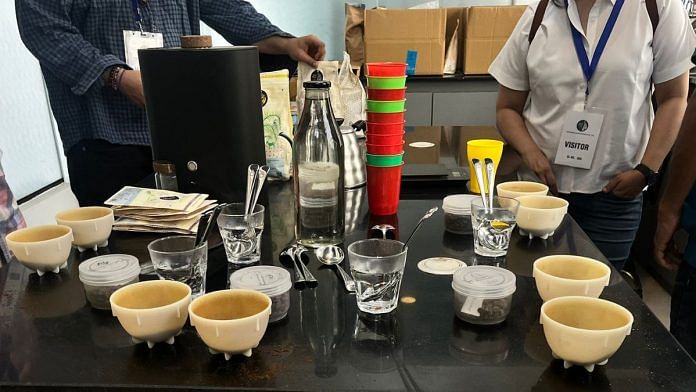New Delhi: Nine people gather around a roaster that’s gushing out hot brown coffee beans. They scoop out the beans, inhale deeply, and spit out questions faster than the machine. “How do humidity and temperature impact the freshness of coffee? How long do coffee beans retain aroma after roasting?”
The group of young men and women are part of a coffee roastery and cupping tour organised by one of India’s premium coffee brands, Blue Tokai, at its headquarters in Gurugram’s Udyog Vihar. And they are more than just coffee nerds. They are invested in the journey of the beans – from farm to cup.
This singular, almost religious approach toward the beverage –is being pushed by the growing tribe of ‘coffee-preneurs’ who have become the face of their brands. They are holding workshops, joining panel discussions, collaborating with cafes, bookshops and even furniture brands. They are evangelising about the bean on every platform.
“Coffee gave me the energy boost I needed before my afternoon gym sessions,” says one of the participants, Garreth D’Mello, a musician and freelance writer.
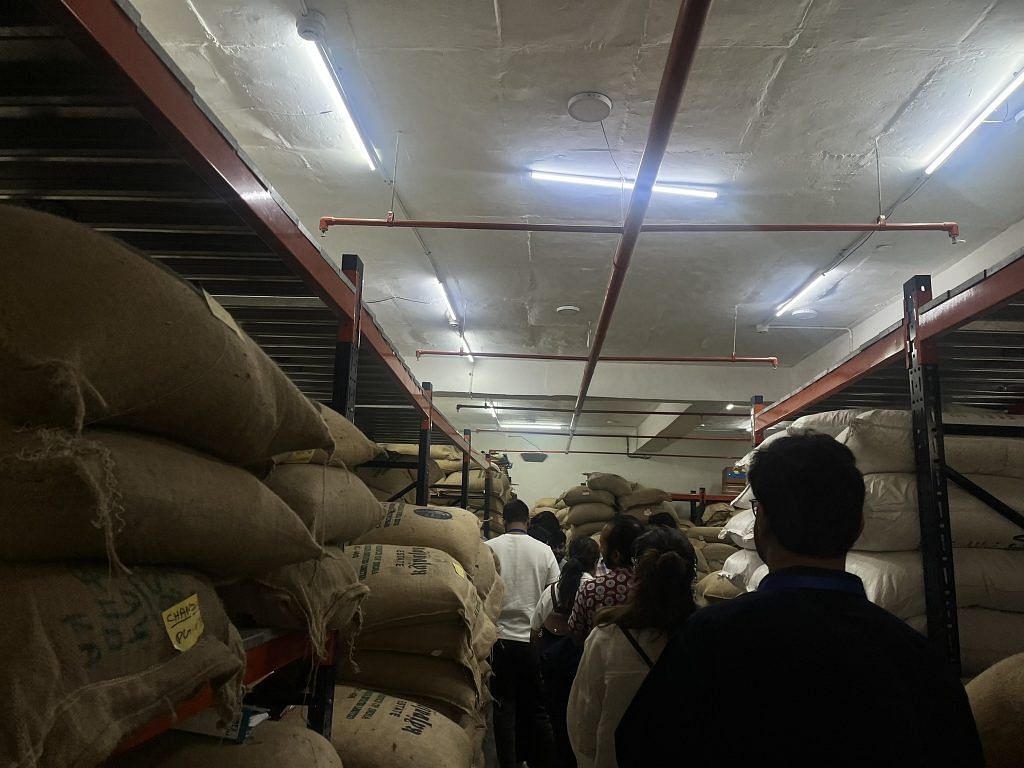
As someone interested in craft beer, the love for coffee came naturally to him. Both beverages involve roasting, flavour development, and craftsmanship. Now, he wants to know how the coffee cherries are processed, how the beans are roasted, and how they can be brewed.
The first wave of international chains like Starbucks and Costa Coffee in the early 2000s set the stage for homegrown brands and single-origin coffees. While brands like Nescafe have a special place in coffee-loving South India, over the past few years, Blue Tokai, Third Wave Coffee, Black Baza, Sleepy Owl, Araku Coffee and Maverick & Farmer have turned drinking coffee into an art, a devotion and an indulgence.
Now, a country of primarily tea drinkers is staring at a new kind of coffee-drinking phenomenon. Coffee now stands on par with wine, whiskey and beer.
Coffee drinkers want to experience different kinds of coffee. They want their palate to be excited. We understood that early – Ashish D’Abreo, Maverick & Farmer Coffee
The tasting session at the end of the Blue Tokai tour is similar to a wine trail. Participants sniff eight different types of black coffee, sip it using tiny spoons, pause to experience the notes and finally swallow.
“Oh, this one has more funky notes,” says one coffee aficionado to murmurs of agreement.
In India, the origin story of specialty coffee is a passion project that has struck gold. Where a cup of tea or instant coffee once cost no more than Rs 10, people now don’t hesitate to splurge over Rs 1,500 for a cup of specialty coffee or shell out Rs 500 for a mere 250 grams of powder or beans.
Industry experts such as Matt Chitharanjan, the CEO and co-founder of Blue Tokai Coffee, and Ashish D’Abreo, founding member of Flying Squirrel and Maverick and Farmer, note that this phenomenon isn’t limited to Delhi, Mumbai, and Bengaluru. It has percolated to Nagpur, Varanasi, and Indore, as well as other Tier-1 and Tier-2 cities.
The potential of the market is such that some say India’s coffee revolution hasn’t even begun yet.
“Many people draw a parallel that India is going to become the next China. Right? China has almost 1 lakh cafes. India right now is sitting at only 5,000. So that just shows you the scope for growth within coffee that can happen between where we’re at now and what it can look like a decade from now,” says Chitharanjan.
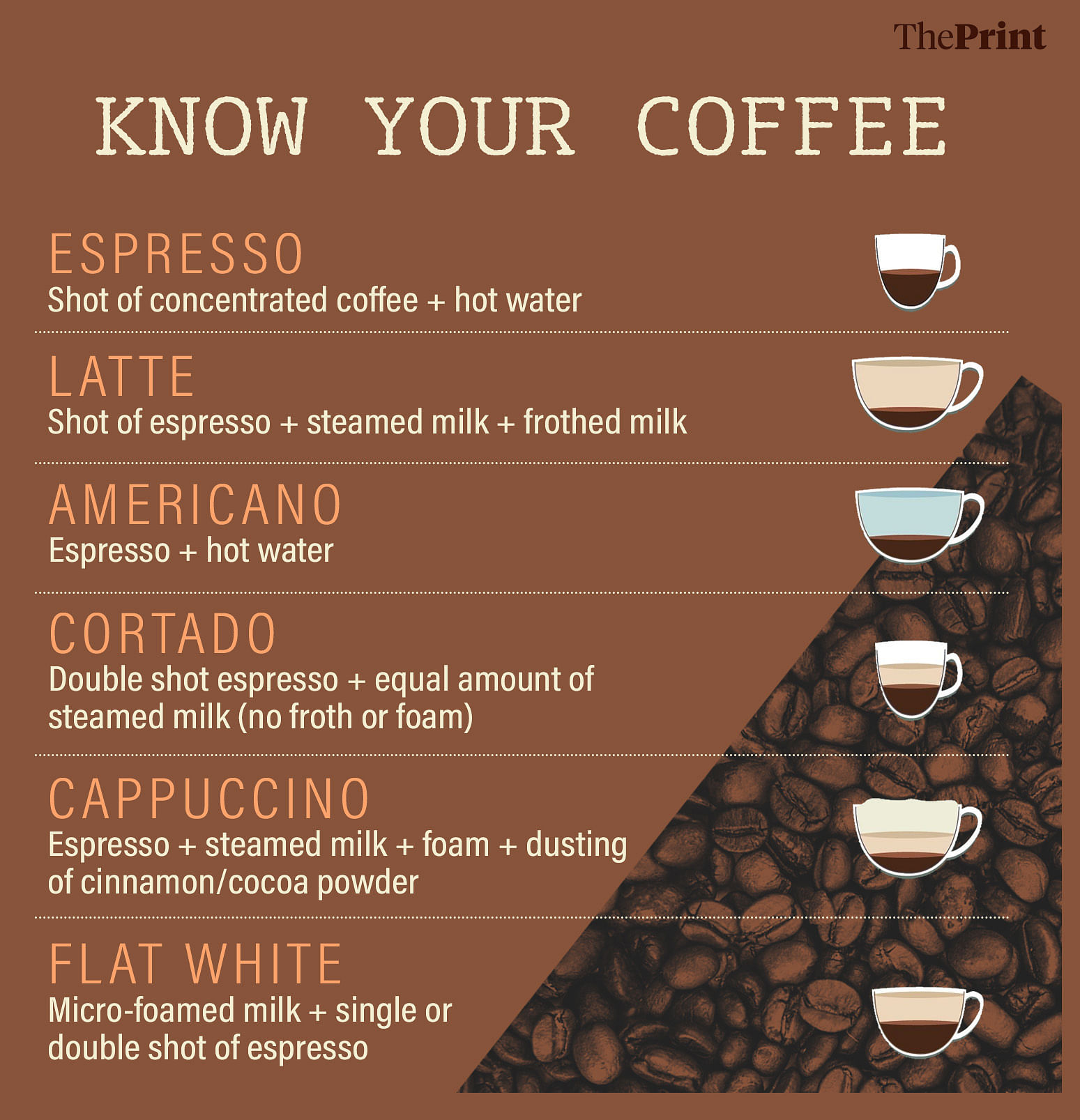
The coffee-preneurs
Matt Chitharanjan – who was born and brought up in Wisconsin – knows that had he started his coffee company in the United States, he would not have been at the centre of India’s coffee show.
A canny businessman, he laid the foundation for Blue Tokai Coffee Roasters in Delhi with his wife Namrata and their third business partner Shivam Shahi. That was in 2013. Today, Blue Tokai has close to 110 outlets across 10 Indian states, along with a roastery and pop-up store in Japan.
“For the first three years, I used to roast all the coffee in the company,” he says.
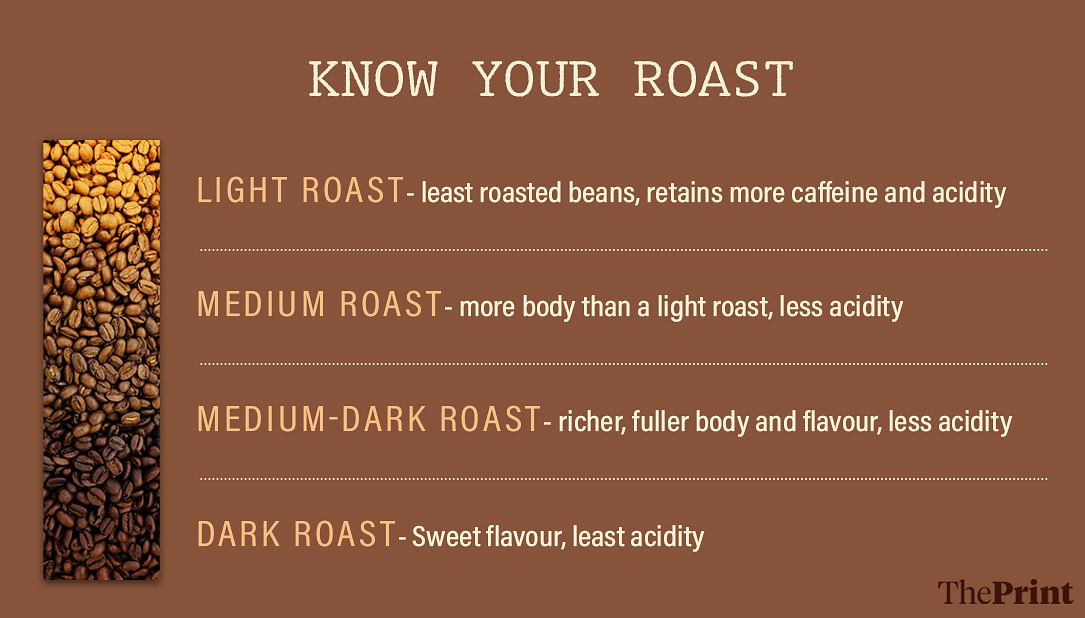
Now, he lets the “people who are far, far better” than him at roasting do the job. He never stops pushing his love for coffee and his brand at panel discussions, podcasts and events.
“The stage that India is [now at] there’s the opportunity to create really interesting and distinct brands that do things in ways that weren’t being done in this country before and build something interesting and meaningful,” says Chitharanjan, whose favourite drink is an Americano.
While Blue Tokai was spreading its wings in northern India, another coffee cup was brewing and bubbling in Bengaluru. A year earlier in 2012, two school friends and coffee lovers – Ashish D’Abreo and Tej Thammaiah – along with entrepreneur and restaurateur Phalgun Chindanand, started Flying Squirrel. Like Blue Tokai, they sold coffee beans and grounds online as well as in their dedicated cafes.
Many people draw a parallel that India is going to become the next China. Right? China has almost 1 lakh cafes. India right now is sitting at only 5,000. So that just shows you the scope for growth within coffee that can happen between where we’re at now and what it can look like a decade from now – Matt Chitharanjan, Blue Tokai Coffee
Ten years later, D’Abreo and Thammaiah are still passionate about their coffee. Their initial venture has lost steam but they are bullish about their new business – Maverick & Farmer Coffee – which they started in 2018 with a third partner, Sreeram Gangadharan. Today, they have two cafes in Bengaluru and one in Goa. But their main business involves direct wholesale supply to restaurants, hotels, co-working spaces, offices, cafes and bars.
Chitharanjan and D’Abreo have attached credibility to the commodities and brands they’ve birthed. The same is true for Arshiya Bose of Black Baza Coffee and Rahul Reddy of Subko Coffee, who are at the forefront of their brands and have made their personality and passion the face of their business.
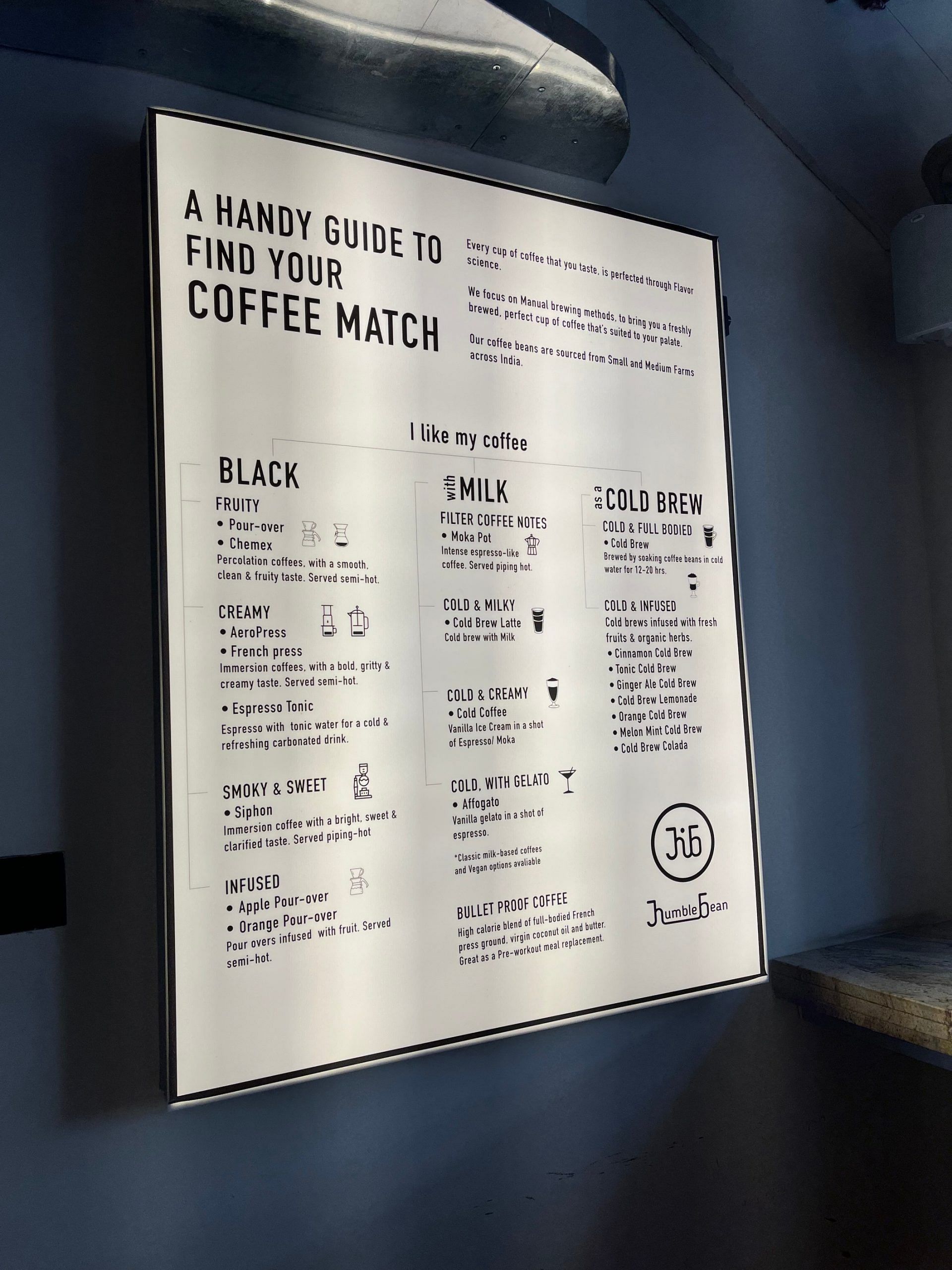
D’Abreo’s love for performing arts keeps him excited about his coffee business.
“Coffee drinkers want to experience different kinds of coffee. They want their palate to be excited. We understood that early,” D’Abreo says, sitting at one of his outlets in Bengaluru’s Koramangala after finishing rehearsals for his upcoming play, Innocence. His side hustle as a theatre actor and director informs his coffee startup as well. He’s constantly urging customers to try new blends.
Maverick & Farmer Coffee send different coffee samples to customers who order the same varieties. And D’Abreo ensures his company launches new blends every three months just to keep things fresh.
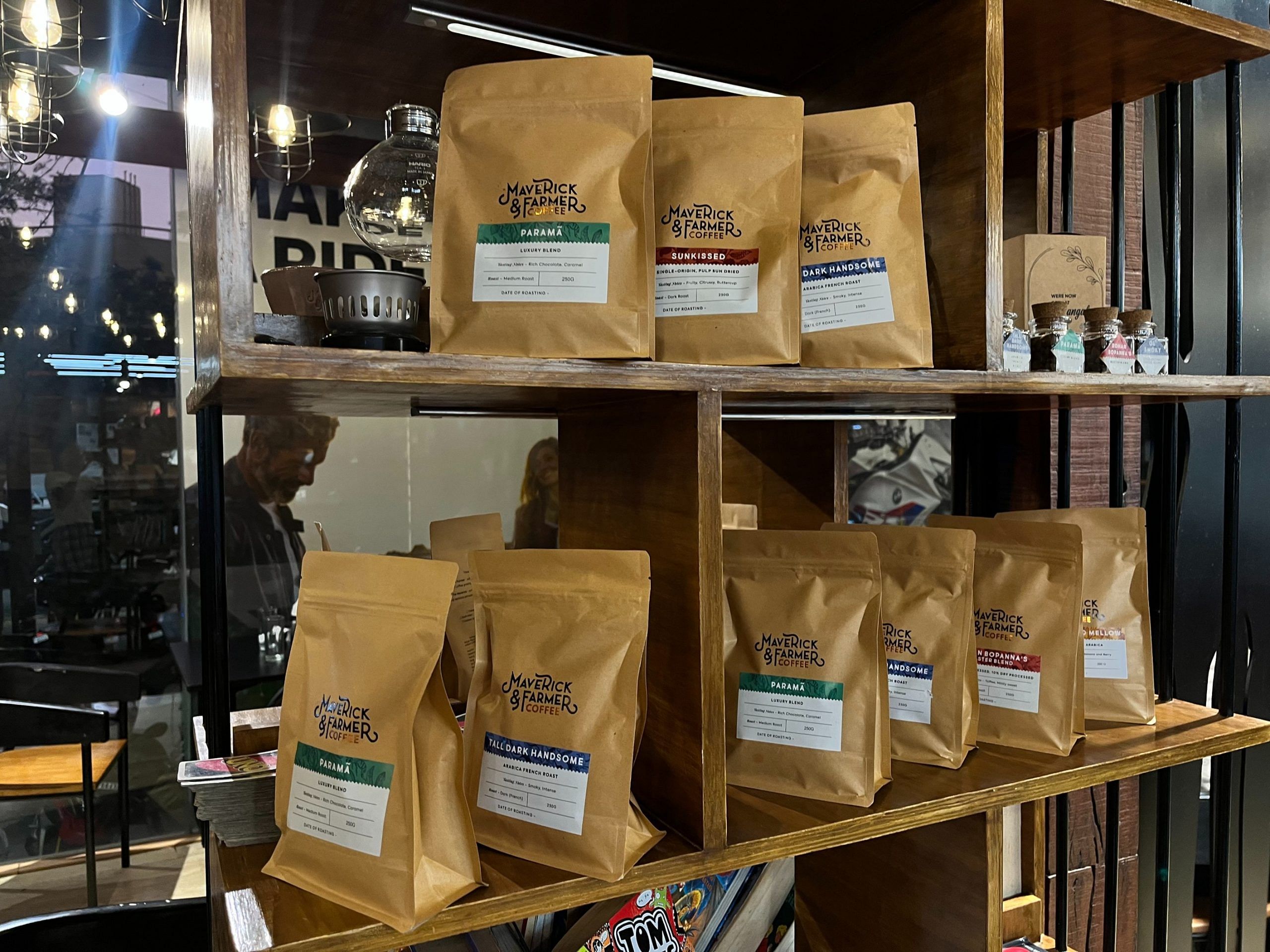
“We have these brainstorming sessions – we call it the ‘what-if meetings’ before the harvest season. It’s the most exciting time of the year. Those ideas are then used during the harvest season,” he says.
Also read: Tulsi to strawberry—How desi gin from Goa is converting India’s vodka loyalists
A booming industry
The beverage is a marker of economic mobility and urban India’s way of flaunting its hard-earned aspirations. Coffee is the cooler, hipper drink.
“The downside of tea is that it is cheaper and readily available. So there is no aspiration associated with having a cup of chai,” says Chitharanjan.
Even back in the day, Nescafe’s iconic ‘The taste that gets you started up’ campaign was about aspiration and independence. Now, it’s also about luxury.
Chitharanjan sees it as the natural progression of a society that is becoming wealthier. The Blue Tokai founder relates it to a combination of factors, including young people experiencing life abroad, returning home and then “wanting to replicate” things they are seeing in other countries.
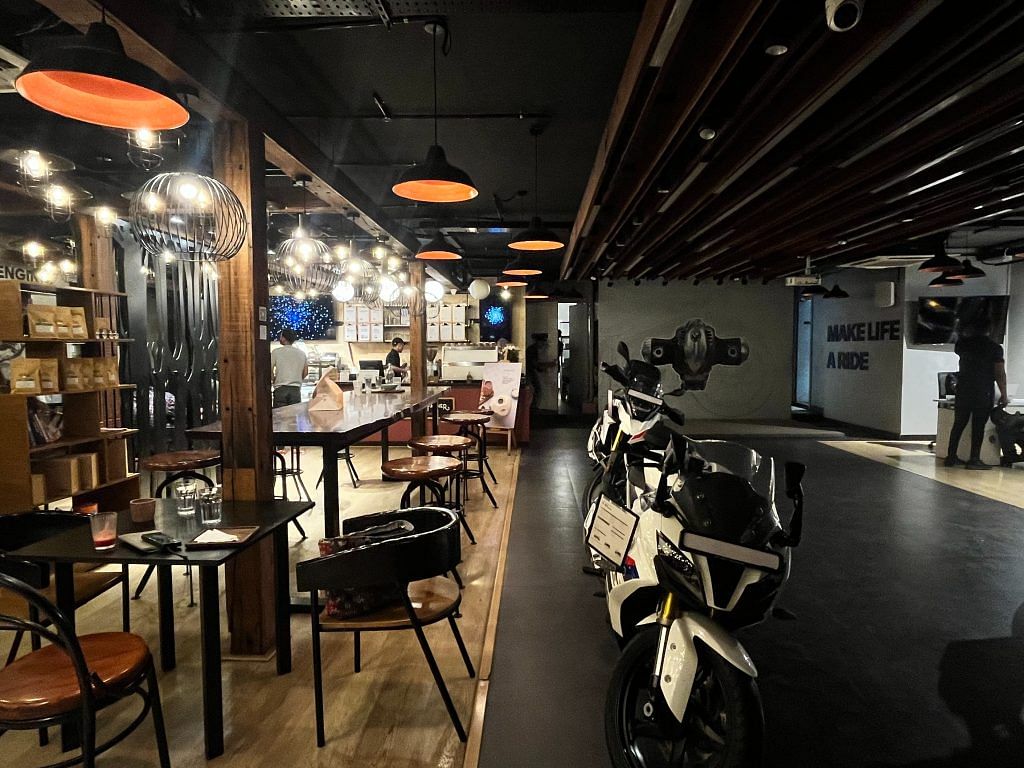
“With India becoming more affluent as a country, people are starting to trade up from older commodity brands to more premium, specialised artisanal, locally produced brands,” says Chitharanjan. He’s quick to add that this is not something unique to the coffee industry. It applies to spirits, beer, meats and many other consumption categories.
Sitting several miles away in Melbourne is another coffee-preneur, Mithilesh Vazalwar. The owner and mascot of Nagpur-based Corridor Seven Coffee Roasters, Vazalwar will be a judge at the Australian Espresso Championship, scheduled to be held from 11-14 May.
“We need to stop behaving like we are the only industry that is super cool,” says Vazalwar with a grin.
The boom in India’s coffee industry is just a stage in its growth trajectory, says Vazalwar, who was a professional badminton player in another life.
The downside of tea is that it is cheaper and readily available. So there is no aspiration associated with having a cup of chai – Matt Chitharanjan, Blue Tokai Coffee
India’s coffee segment is almost a decade-and-a-half behind global players, he stresses, adding that Australia’s coffee movement occurred way back in 2003. However, Vazalwar credits the Covid-19 pandemic with pushing interest and enthusiasm by five years.
“It [coffee] was always knocking on India’s door, waiting for us to accept it as a serious contender,” he says while dog-sitting a husky at his friend’s apartment in Melbourne.
Vazalwar’s coffee shop in Nagpur sees 600-700 visitors a day, and he’s looking to take his brand to other smaller cities. However, he isn’t the only one vying to make his mark in a growing industry. According to D’Abreo, a lot of their business-to-business (B2B) customers are from Tier-2 cities.
“They are far more passionate and less jaded,” he says about his clients. There is no real-estate heat to be dealt with, it’s still an untapped market.
“Of course, it’s where Bangalore was 10 years ago,” he adds.
The Indian coffee palate is still evolving. Most people – even those in metropolitan cities — still opt for sweeter, milkier flavours. But irrespective of taste preferences, the specialty coffee trend has reached Tier-2 cities.
According to D’Abreo, this has more to do with the “introduction of an idea” and not just spending power. The drink has become integral to the lives of many corporate workers and gym-goers.
“It’s an intermingling between lifestyle and necessity.”
Also read: Royal, rich, Rajputi—Indian single malt whisky now global cool. A new culture being distilled
Coffee meets IT, marketing, storytelling
Up until 1996, selling coffee in the country was the exclusive prerogative of a government body, the Coffee Board of India. All coffee planters had to submit their entire crop to a pool managed by the body. It was only after the pooling system was abolished in 1996 that growers were allowed to sell to processing firms.
Ashok Kuriyan, the managing director at Balanoor Plantations, which farms specialty coffee, has seen the bean’s transformation up close. Sitting inside a spacious conference room at his office in Bengaluru’s Shivaji Nagar, Kuriyan attempts to link India’s coffee culture boom to its IT revolution in the 2010s.
“My perception of this is that it all picked up because of the travel that Indians were doing. It is largely connected with our software people, who started travelling to America and Europe” says Kuriyan, now in his 70s. From what he’s seen, people went abroad and experienced a different coffee-drinking culture. It was about the beans, the roasts, the grounds, and the way it was served — black, espresso, latte, cappuccino. They returned home and made coffee fashionable.
I’m a coffee evangelist. There are different ways of evangelising. Some use guilt. For me, I do it if I see a scope to convert. I recently gifted a french press to two of my friends. That’s my way – Jai Warrier, climate and sustainability consultant
It became a fixture in the Indian corporate world with offices investing in fancy coffee machines. D’Abreo acknowledges that coffee players were “aided by” multinational corporations that were setting up offices in India at the time.
“They were hiring a lot of local talent and then exposing them to press-button coffee machines,” he says. The phrase “Let’s meet over a drink” evolved into “Let’s meet over coffee”.
In the Balanoor Plantations’ conference room, nearly 10 coffee packets from different companies are neatly displayed on a coffee table. These are the brands to which the Kuriyans supply their coffees, one of them being Blue Tokai.
Ashok Kuriyan’s son, Rohan, is impressed with the packaging used by these brands.
“They are eye-catching and the marketing that has been carried out in the coffee industry is just something of another level. It is photographable,” says the fifth-generation coffee grower.
Blue Tokai’s original coffee packets have been upgraded to beige ones sporting a combination of Gond and Kalamkari artwork. Black Baza, on the other hand, relies on minimal design—its biodegradable brown packets feature an animal or a plant linked to the places from where the coffee is usually sourced. The beans come primarily from estates in Karnataka followed by Kerala and Tamil Nadu.
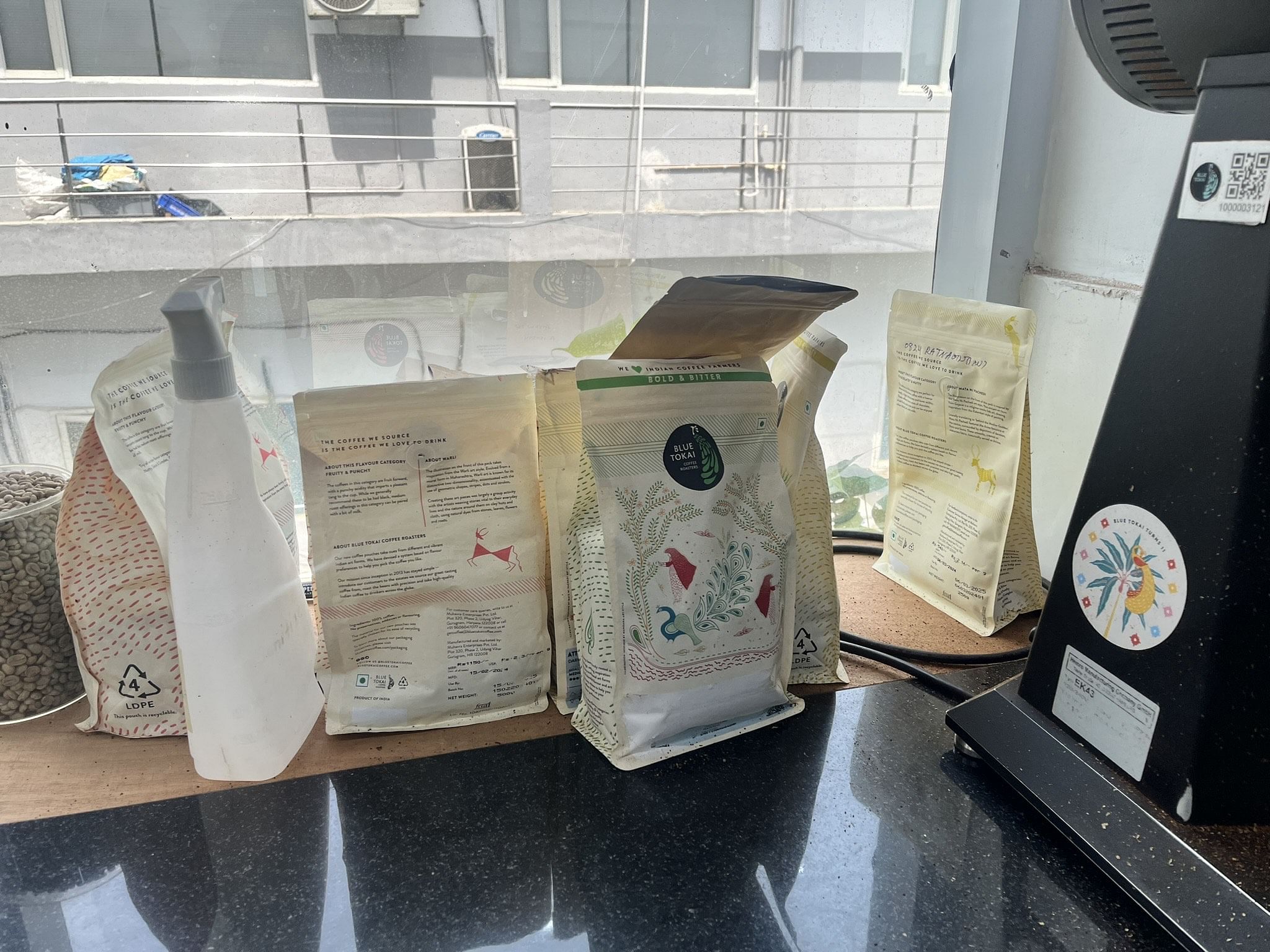
The packaging alone makes for tempting Instagrammable photos and content. D’Abreo, who spent 12 years in the advertising industry, sees coffee as a product that by virtue has the possibility of being “more vibrantly marketed”.
That’s an opportunity coffee-preneurs didn’t miss out on capitalising. Content related to coffee overflows on every social media platform. From videos like ‘Five Hacks to Improve French Press’ to ‘Mastering the Art of Pour Over Coffee’, the internet is replete with YouTube videos and Instagram Reels on specialty coffee.
The marketing that has been carried out in the coffee industry is just something of another level. It is photographable – Rohan Kuriyan, Balanoor Plantations
Every sip of specialty coffee is accompanied by talks about the estate where it’s grown, who is growing it and how it’s brewed. Browsing through Black Baza’s website is more than online shopping for coffee. It’s also about garnering knowledge on the “geographical, sociocultural and ecological life histories” of the coffee beans. Their website’s ‘know your coffee section’, has information on grinding coffee, their roastery as well as dos and don’ts for first-time users of coffee equipment.
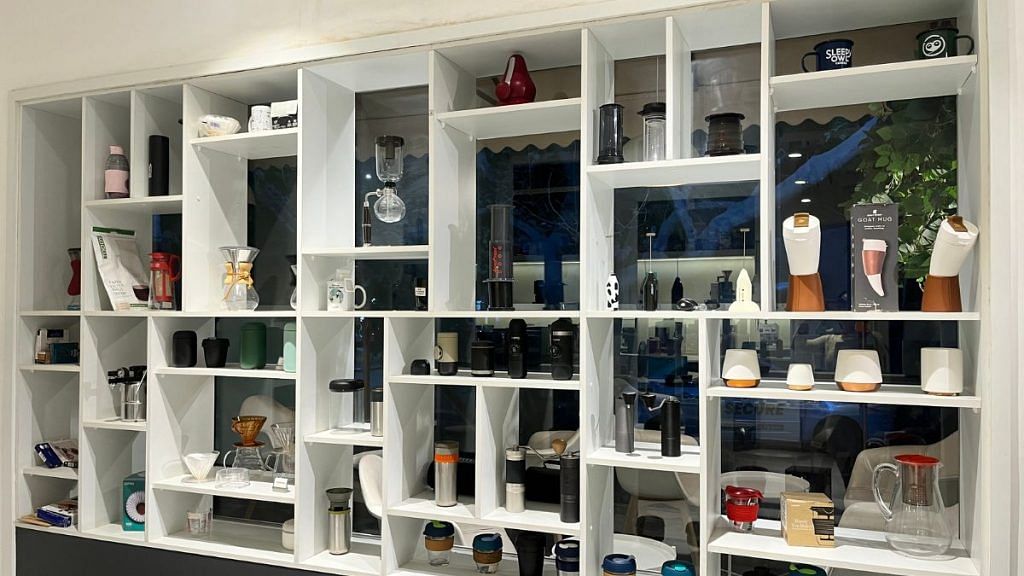
“It’s considered a creative drink. People say let’s get a coffee and think about it. So it has inherently got that platform,” says D’Abreo.
Also read:
Coffee evangelists
Coffee is now a whole new world with its own distinct terminologies. There’s a cache in knowing the difference between a bloom and a cortado, and the levels of acidity in different roasts.
It’s how Bengaluru-based Jai Warrier became drawn to coffee.
There was a time when he gulped down filter coffee or instant concoctions without a second thought. But a 2020 Christmas trip to Kodaikanal, which is known for its coffee estates, as well as the influence of office colleagues, converted Warrier into a coffee purist.
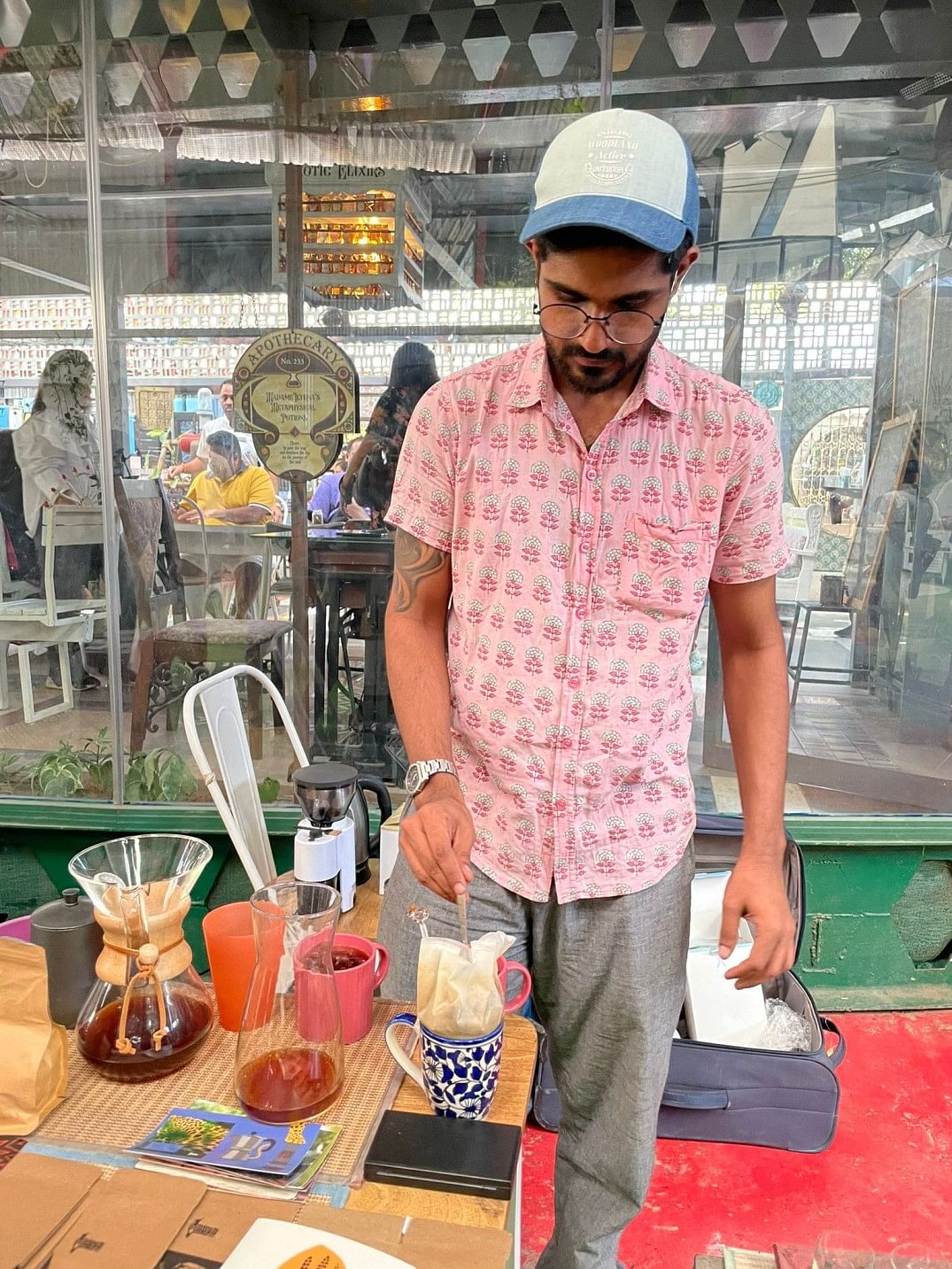
“It’s a religious kind of connection. I walk my dog in the morning and then spend 20 minutes making a cup of coffee. It’s a ritual,” he says.
Warrier’s dedication and devotion to coffee has reached a fevered pitch. The climate and sustainability consultant is now trying to mix his passion with work. In April this year, he set up a stall at a farmers’ market in Bengaluru to inform people about good and sustainable coffee. On a tiny table, he had a French press, a manual drip coffee maker, a few cups and several coffee packets.
His main objective was to educate people on good coffee, which Warrier admits can be very subjective. Nonetheless, he wants people to know how they can brew better coffee at home and where to buy it from.
Warrier attends coffee talks and routinely follows YouTube coffee influencers like James Hoffman and Lance Hedrick and channels like Coffee with April. He also voraciously consumes all debates and discussions about his favourite beans.
“I’m a coffee evangelist. There are different ways of evangelising. Some use guilt. For me, I do it if I see a scope to convert. I recently gifted a french press to two of my friends. That’s my way,” he said.
A dedicated coffee fan, he is part of an active WhatsApp group where people share pictures of coffee they have made, as well as information on brewing equipment and other coffee-related content.
But these days, his evangelism has taken on a more urgent note. He’s started talking about the drought in Karnataka and the impact of climate change on the bean.
“If people are interested in the link between climate change and coffee, I show them how they can support farmers by buying from the right brands,” he says.
Away from the glamour of the bean, there’s a real worry about the impact of drought in Karnataka. Many have likened it to the Sword of Damocles, hanging over India’s flourishing coffee industry.
“It’s really, really, really horrible. Reservoirs are drying up because there is no rain and irrigation is expensive. It’s a scary situation,” says D’Abreo, taking a long sip from his cup of coffee.
(Edited by Zoya Bhatti)


